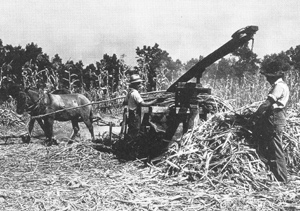
Sorghum-making
The common term for sorghum syrup in Tennessee is “molasses” or “sorghum molasses,” though educated agriculturists have unsuccessfully campaigned against the use of these vernacular synonyms. Molasses is a by-product of sugar making and may derive from sugar cane or beets; sorghum syrup is the pure, condensed juice of sweet sorghum cane, a subtropical grass first imported to America in 1853 as a possible source for commercial sugar supplies. The 1857 importation of sixteen African varieties to Georgia and South Carolina made this grass a southern crop, and by 1859 syrup production had reached almost seven million gallons per year. The production of sorghum syrup became an enterprise of small farmers and has retained the traditional language, farming practices, and syrup-making procedures of this producer class.
Currently, some eighty Tennessee producers keep four hundred acres in sorghum cane, down from three thousand acres in the 1950s. Until the early 1970s, West Tennessee ranked as the major sorghum growing region of the state, with Benton County providing up to 40 percent of total production. A state survey from 1988 to 1990 found 85 percent of the producers in Middle and East Tennessee and 73 percent of farmers growing five acres or less. Eighty percent of these small farmers still grew their crop from seed saved from the previous year’s planting, thereby maintaining traditional varieties of cane; 87 percent cut their cane by hand; and 80 percent stripped the cane leaves by hand. Twelve percent of all producers still used horse-powered mills for squeezing juice from the cane, and 38 percent sold their product in traditional four-pound tins. A “stir-off,” or gathering to press juice and cook it down to syrup, has been a harvest season tradition in many families and communities since the late nineteenth century.
Not surprisingly, the process of producing sorghum syrup also follows traditional methods. Farmers normally cut the tropical sorghum cane before frost. They strip the leaves from the standing cane and “top” it (remove the seed heads) after harvest. Sorghum cane mills are often built from refitted nineteenth-century sugar cane processing machinery. The ground cane stalks may be used for fodder. Juice is always cooked on the same day of extraction. Evaporator pans, heated by hardwood coals, propane, or steam, are typically shallow, stainless steel troughs, baffled to allow juice to thicken as it passes from one section to another. As the strained, raw juice cooks down, chlorophyll and starchy material coagulate and float to the top, and must be skimmed from the surface to avoid a bitter-tasting product. “Skimmings” may be fed to livestock, though some producers hide them in a “skimming hole,” a trap into which an unwary visitor might step, providing amusement for the crowd.
Traditionally, a sorghum-maker evaluates the readiness of syrup by observing the bubbles of the boiling juice and its thickness as it drips from a ladle. After a batch has been poured off, it is judged for its color, sweetness, texture, clarity, and flavor by the maker and the bystanders. Scorched syrup is fed to hogs and cattle.
Tennessee has been a consistent leader in the production and sale of sorghum syrup, often ranking first or second nationally.
Suggested Reading
A. Hugh Bryan, “Sorghum Syrup Manufacture,” United States Department of Agriculture Farmers Bulletin 477 (1912)



